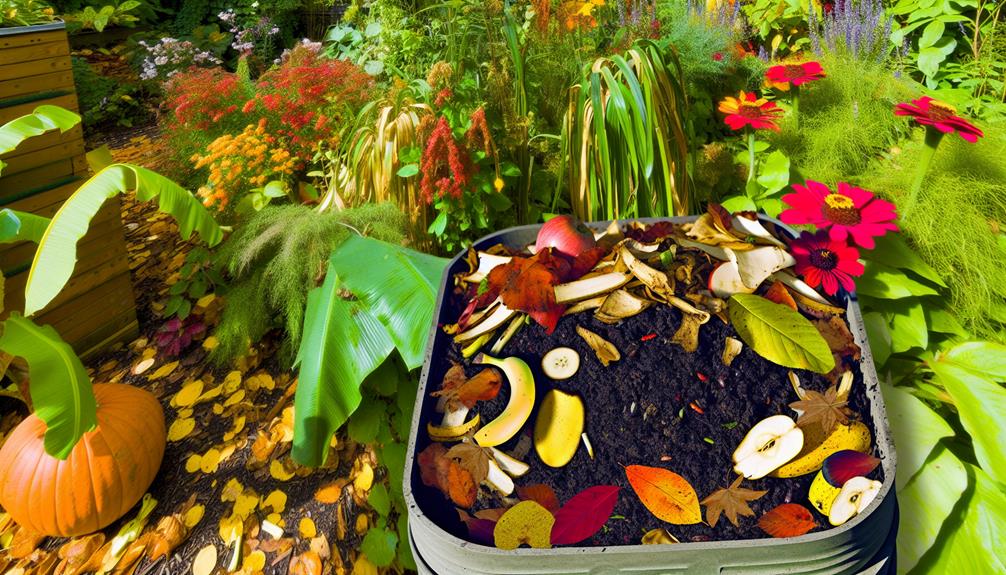

You can definitely compost banana peels! They’re fantastic for enriching your garden soil with essential nutrients like potassium, phosphorus, and calcium—crucial for robust plant growth. Chop them into small pieces to speed up decomposition, balancing them with dry materials like leaves for the perfect compost mix.
Turning your compost pile regularly and monitoring moisture levels helps beneficial microorganisms break down the peels efficiently, reducing the need for chemical fertilizers and encouraging healthy plant growth. Plus, composting banana peels helps reduce landfill waste and supports a more sustainable lifestyle. Want to maximize your compost’s potential? Keep going for more tips!
By composting banana peels, you can enrich your soil with essential nutrients. This practice not only benefits your garden but also helps you connect with a community of eco-conscious individuals.
When you compost, you’re reducing waste and promoting a sustainable lifestyle. Banana peels decompose quickly, providing organic matter that improves soil structure, enhances moisture retention, and promotes healthy plant growth.
By integrating composting into your routine, you join others who care about the environment and sustainable living. Imagine the satisfaction of seeing your plants thrive, knowing you contributed to their health.
Plus, you’re cutting down on landfill waste, which is a shared responsibility we all can take part in. Embrace composting and make a positive impact together!
Also Read: Can You Compost Bacon Grease?
Did you know banana peels are packed with essential nutrients like potassium, phosphorus, and calcium that can greatly benefit your garden soil? Imagine the lush, vibrant plants that could thrive with these crucial natural fertilizers.
When you add banana peels to your compost, you’re giving your garden a nutrient boost that can make a world of difference. Here are some key nutrients found in banana peels:
To prepare banana peels for composting, start by chopping them into small pieces to speed up decomposition. By doing this, you create more surface area, allowing microbes to break down the peels faster. Smaller pieces also blend more seamlessly into your compost mix, promoting even nutrient distribution.

After chopping, consider soaking the peels in water for a day. This softens them, making it easier for microorganisms to start the decomposition process. You can also blend the peels into a puree, which integrates quickly into your compost bin.
Also Read: Composting Bread: Unveiling the Truth About Bread Waste
Once you’ve prepared the banana peels, integrate them into your compost pile to enhance nutrient content. Banana peels are rich in potassium, phosphorus, and calcium, which are essential for healthy plant growth. By adding banana peels, you’ll create a thriving compost environment that benefits both your garden and the ecosystem.
Consider these steps when adding banana peels to your compost:
When composting banana peels, it’s important to avoid common mistakes that can disrupt the process. Make sure you don’t add non-compostable items. Maintain proper moisture levels to prevent your pile from getting too dry or too soggy. Regularly turn your compost to guarantee good aeration.
Throwing non-compostable items into your compost bin is one of the most common mistakes gardeners make. It’s easy to think everything organic belongs in the compost, but that’s not the case.
Adding the wrong items can slow down decomposition and attract pests. Avoid these items to keep your compost healthy:
Sticking to compost-friendly materials ensures a nutrient-rich, thriving compost pile, bringing you closer to your gardening community.
While avoiding non-compostable items is key, maintaining proper moisture levels is another critical aspect of successful composting. Your compost pile needs to be as damp as a wrung-out sponge.
Too much water can lead to a slimy, smelly mess, while too little water slows down the decomposition process. To achieve balance, mix in dry materials like leaves or straw if your pile is too wet, and add water if it feels too dry.
Regularly check and adjust the moisture. Remember, keeping the right moisture level helps your compost break down efficiently, creating a nutrient-rich soil amendment. Your efforts contribute to a more sustainable environment, and being part of this green movement can be incredibly rewarding!
Neglecting compost aeration can lead to a sluggish, foul-smelling pile that hinders the decomposition process. By not turning your compost, you’re depriving it of essential oxygen, which aerobic microbes need to break down materials efficiently.
To keep your compost thriving, make sure you:
Also Read: Can You Compost Balloon?
You can easily compost banana peels indoors with just a few simple steps.
First, find a small compost bin or container that fits well in your kitchen. Add a layer of shredded paper or cardboard at the bottom; this helps with airflow and prevents odors.
Next, chop your banana peels into smaller pieces to speed up decomposition. Add the peels to your bin along with other kitchen scraps like coffee grounds and vegetable peels. Mix the contents regularly to keep the compost aerated.
Finally, sprinkle in a bit of water if the mixture looks dry. This maintains a balanced moisture level, essential for effective composting.
Once your compost is ready, it’s time to enrich your garden soil with its nutrients. You’ll be amazed at how your plants respond to this natural boost. Spread a layer of compost over your garden beds, ensuring even coverage. This organic material will improve soil structure, retain moisture, and provide essential nutrients.

Embrace the sense of community and connection that comes from nurturing your garden with homemade compost.
Also Read: Can You Compost Bacon?
Dealing with common composting problems quickly can keep your compost heap healthy and efficient. If your pile smells bad, it’s likely too wet or lacking oxygen. Turn it more often and add dry materials like leaves or straw. If it’s not breaking down, the pile might be too dry—sprinkle some water and mix well.
Seeing pests? You might be adding the wrong food scraps. Avoid meat, dairy, and oily foods. If your pile’s too cold, it needs more nitrogen-rich materials like grass clippings or kitchen scraps. Remember, a balanced mix of greens and browns is key.
Composting banana peels is a fantastic way to enrich your garden soil while reducing waste. You’ll benefit from the rich nutrients they provide, like potassium and magnesium.
By properly preparing and adding banana peels to your compost, you can avoid common mistakes and guarantee a successful composting process.
Whether you compost indoors or outdoors, the end result is nutrient-rich compost that will boost your garden’s health.
So, start composting those banana peels and watch your garden thrive!
